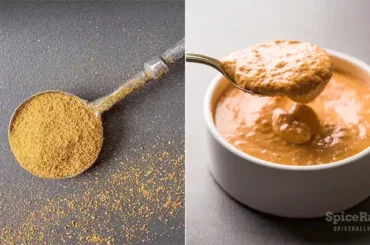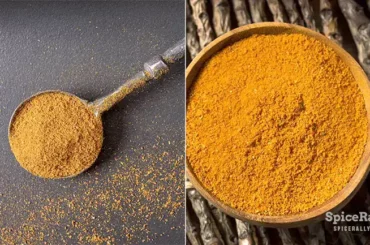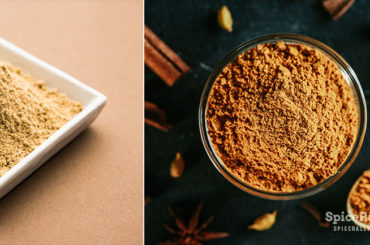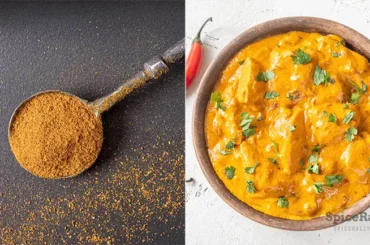If someone ever asks you what spice blends you easily get confused with, we are sure curry powder and Garam Masala would be on top of your list! Thus, we are delighted to share this article which will explain everything you need to know about curry powder vs Garam Masala.
The key differences between Garam Masala and curry powder come down to their flavor and some of their ingredients. For example, turmeric is an essential spice in curry powder, whereas it is not typically a part of Garam Masala. Moreover, Garam Masala contains stronger and warmer spices compared to curry powder. Consequently, their flavor profiles and usage in cooking tend to differ.
So, what’s more about these two flavorful spice blends? Let’s dig in with the rest of this episode.

Curry Powder Vs Garam Masala- Difference Elaborated.
To begin with, both of these mixtures are combinations of several flavorful spices. However, Garam Masala originally comes from Indian cuisine. While on the contrary, curry powder is an Indian-inspired British creation.
Even though both of them share a set of similar ingredients, the flavor profiles of these spice blends have significant differences. Turmeric is a key ingredient and the base colorant in curry powder. But we don’t usually savor turmeric in Garam Masala. Accordingly, the colors of these two blends tend to differ.
In addition, Garam Masala contains more warming and potent spices than curry powder. Accordingly, the flavor profile of curry powder is milder than that of Garam Masala. Nevertheless, both the mixtures do not have standard recipes. Hence, the recipes change depending on the household and the brand.
So, use the table below to have a clear picture of curry powder vs Garam Masala.
| Garam Masala | Curry Powder | |
|---|---|---|
| Ingredients | – Green cardamom – Black cardamom – Cloves – Cumin – Nutmeg – Mace – Coriander seeds – Cinnamon – Black pepper – Bay leaves – Fennel seeds – Ginger – Caraway seeds – Star Anise – Kashmiri Red Chili | – Turmeric – Coriander seeds – Cumin seeds – Black pepper – Fenugreek – Garlic – Ginger – Cinnamon – Mustard seeds – Cloves – Red chilies (paprika/ cayenne pepper, Kashmiri red chilies) Some variations might also include: – Allspice – Curry leave – Bay leaves – Nutmeg – Fennel seeds – Cardamoms |
| Base Flavor | Savory and spicy | Savory and spicy |
| Flavor Profile | Bolder, heavier, stronger, and flavorful than curry powder with warm, earthy, and spicy flavor notes. | Less flavorful and potent than Garam Masala with a gently warm, earthy, and savory undertone. |
| Texture | Powdered spice mixture | Powdered spice mixture |
| Color | Has a brownish hue | Yellow in color |
| Mode of usage in cooking | Usually used as a finishing spice in cooked food. | As an ingredient that is added during the cooking process. |
| Usages in cooking | – With meat, fish, and seafood – As a seasoning in wrap fillings – With vegetable dishes – With soups and stews – To make various lentil dishes – With rice, quinoa, and couscous dishes | – With meat, egg, fish, and other seafood dishes – To make curries – To be incorporated into the fillings of fried food/snacks. – In savory rice dishes – With salads and chutneys – To use as a dry rub and an ingredient in wet rubs or marinades |
| Origin | Indian cuisine | Western cuisine (curry powder is actually an Indian-inspired British creation) |
| Availability | – It comes in containers or packets – Can be purchased from supermarkets, online sellers, and Asian grocery stores. | – Comes in containers and packets – Widely available in any grocery store, supermarket, and online shopping site. |
| Storage | – Once opened, store in a glass, tight-fitting container in a dark, dry, cool place. – Can be stored in your spice cabinet with the rest of your spices. | – Once opened, store in a glass, tight-fitting container in a dark, dry, cool place. – Can be stored in your spice cabinet with the rest of your spices. |
Conclusion
Curry powder and Garam Masala are excellent food taste enhancements that could elevate the quality of your dishes instantly. However, as you see, although both of them have some similarities with the ingredients used and texture, they still have considerable differences in terms of their flavor profiles, usage in cooking, origins, etc.




